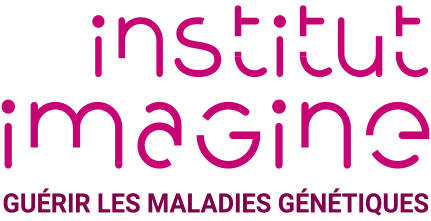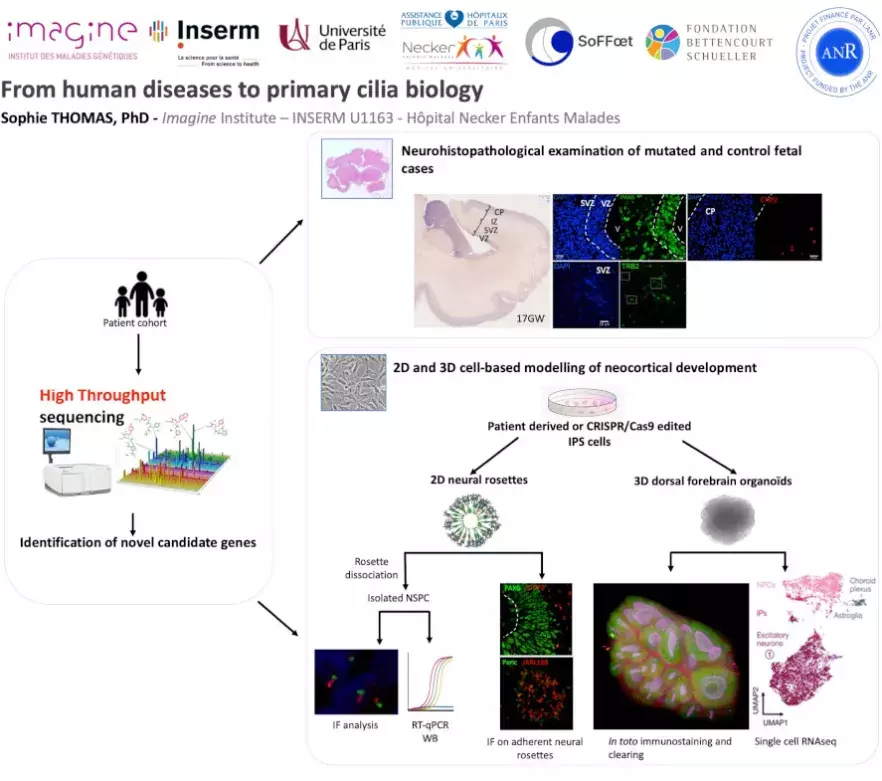Presentation
Sophie THOMAS, PhD, HDR, Principal Investigator
Sophie Thomas and her group work on rare developmental diseases grouped under the term ciliopathies and the consequence of abnormalities in primary cilium biogenesis or function secondary to mutations in genes encoding centrosomal or ciliary proteins. In particular, her research work is focused on the role of the primary cilium in the development of the central nervous system (CNS).
Ciliopathies can lead to CNS malformations (neural tube defect, agenesis of the corpus callosum), cerebellar dysplasia, microcephaly, or cognitive and/or behavioral disorders without any neuroanatomical basis. All types of neocortical progenitors and neurons have a primary cilium that regulates the mechanisms associated with their expansion, fate, migration and maturation.
Sophie Thomas' group has developed a multifaced approach including human genetics, neurohistopathology and 2D and 3D cell-based models of neocortical development (i.e. neural rosettes and cerebral organoids) generated from patient IPS cells (see Figure and movies below), in order to further dismantle the molecular and cellular basis of ciliopathies and to dissect the role of the primary cilium during CNS development, from neural tube patterning to corticogenesis.
ORCID ID: https://orcid.org/0000-0002-8569-3277
ResearcherID: https://publons.com/researcher/2128808/sophie-thomas/
Resources & publications
-
 2020Journal (source)Am. J. Hum. Genet.
2020Journal (source)Am. J. Hum. Genet.Bi-allelic Variations of SMO in Humans Cause a Broad Spectrum of Developmenta...
-
 2019Journal (source)Biol Cell
2019Journal (source)Biol CellCilia in hereditary cerebral anomalies.
-
 2015Journal (source)Am J Hum Genet
2015Journal (source)Am J Hum GenetMutations in KIAA0586 Cause Lethal Ciliopathies Ranging from a Hydrolethalus ...
-
 2012Journal (source)Am J Hum Genet
2012Journal (source)Am J Hum GenetTCTN3 mutations cause Mohr-Majewski syndrome.
-
 2009Journal (source)Hum Mutat
2009Journal (source)Hum MutatCC2D2A mutations in Meckel and Joubert syndromes indicate a genotype-phenotyp...
-
 2010Journal (source)Nat Genet
2010Journal (source)Nat GenetMutations in TMEM216 perturb ciliogenesis and cause Joubert, Meckel and relat...
-
 2011Journal (source)Nat Genet
2011Journal (source)Nat GenetKIF7 mutations cause fetal hydrolethalus and acrocallosal syndromes.
-
 2012Journal (source)Nat Med
2012Journal (source)Nat MedGene therapy rescues cilia defects and restores olfactory function in a mamma...
-
 2012Journal (source)Science
2012Journal (source)ScienceEvolutionarily assembled cis-regulatory module at a human ciliopathy locus.
-
 2009Journal (source)Nat. Genet.
2009Journal (source)Nat. Genet.Highly conserved non-coding elements on either side of SOX9 associated with P...
-
 2015Journal (source)J Cell Biol
2015Journal (source)J Cell BiolTMEM231, mutated in orofaciodigital and Meckel syndromes, organizes the cilia...
-
 2019Journal (source)Hum Mol Genet
2019Journal (source)Hum Mol GenetAltered GLI3 and FGF8 signaling underlies acrocallosal syndrome phenotypes in...
-
 2015Journal (source)Eur J Hum Genet
2015Journal (source)Eur J Hum GenetIdentification of a novel ARL13B variant in a Joubert syndrome-affected patie...
-
 2014Journal (source)Hum Mutat
2014Journal (source)Hum MutatA homozygous PDE6D mutation in Joubert syndrome impairs targeting of farnesyl...
-
 Journal (source)J Neuropathol Exp Neurol
Journal (source)J Neuropathol Exp NeurolNeuropathological Hallmarks of Brain Malformations in Extreme Phenotypes Rela...
-
 2018Journal (source)Am J Med Genet A
2018Journal (source)Am J Med Genet ALoss of function IFT27 variants associated with an unclassified lethal fetal ...
-
 2010Journal (source)J Med Genet
2010Journal (source)J Med GenetBBS10 mutations are common in 'Meckel'-type cystic kidneys.
-
 2018Journal (source)Birth Defects Res
2018Journal (source)Birth Defects ResA neuropathological study of novel RTTN gene mutations causing a familial mic...
-
 2018Journal (source)Hum Mol Genet
2018Journal (source)Hum Mol GenetBasal exon skipping and nonsense-associated altered splicing allows bypassing...
-
 2013Journal (source)Eur J Hum Genet
2013Journal (source)Eur J Hum GenetPhenotypic spectrum and prevalence of INPP5E mutations in Joubert syndrome an...
-
 2013Journal (source)Clin Genet
2013Journal (source)Clin GenetOFD1 mutations in males: phenotypic spectrum and ciliary basal body docking i...
-
 2015Journal (source)J Med Genet
2015Journal (source)J Med GenetIFT81, encoding an IFT-B core protein, as a very rare cause of a ciliopathy p...
-
 2017Journal (source)Am J Med Genet A
2017Journal (source)Am J Med Genet APrenatal and postnatal presentations of corpus callosum agenesis with polymic...


